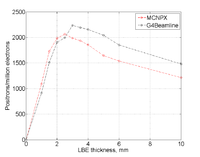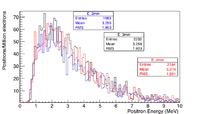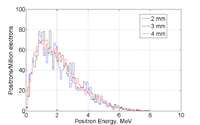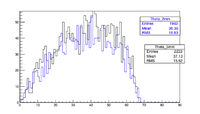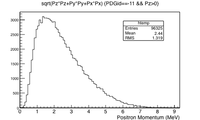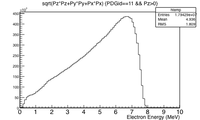Difference between revisions of "G4Beamline PbBi"
| Line 73: | Line 73: | ||
=== 2mm thick, 10 MeV, 1 cm cylindrical incident electron distribution=== | === 2mm thick, 10 MeV, 1 cm cylindrical incident electron distribution=== | ||
| + | I was unable to do anything other than a gaussian beam right now, I will try to do one later | ||
| + | |||
| + | For now I have a gaussian with an 8mm RMS and 10 MeV incident electrons as shown below. | ||
| + | |||
| + | The positron and electron momentum distributions after the PbBi converter are shown below | ||
| − | |||
[[File:4-30-2015_PositronMomentum_2mm.png| 200 px]][[File:4-30-2015_ElectronMomentum_2mm.png| 200 px]] | [[File:4-30-2015_PositronMomentum_2mm.png| 200 px]][[File:4-30-2015_ElectronMomentum_2mm.png| 200 px]] | ||
| + | |||
| + | A comma delimited text file with the above events in the format of | ||
| + | |||
| + | x,y,z,Px,Py,Pz | ||
| + | |||
| + | in units of cm for distance and MeV for momentum is located at | ||
| + | |||
| + | for positrons | ||
| + | |||
| + | and | ||
| + | |||
| + | |||
| + | for electrons | ||
==Solenoid== | ==Solenoid== | ||
[[Positrons#Simulations]] | [[Positrons#Simulations]] | ||
Revision as of 17:44, 30 April 2015
Development of a Positron source using a PbBi converter and a Solenoid
Converter target properties
Definition of Lead Bismuth
1cm diameter target
2 mm thick PbBi
0.5 Tesla solenoid
G4BeamLine and MCNPX
Target thickness optimization
First simple test is to send 1 million, 10 MeV electrons towards a PbBi target and count how many positrons leave the downstream side
The Random number seed is set by Time in G4beamline to use a different set of pseudo random numbers each time it is run
The G4Beamlin incident electron beam has the following properties
beam gaussian particle=e- nEvents=1000000 beamZ=0.0
sigmaX=1.0 sigmaY=1.0 sigmaXp=0.100 sigmaYp=0.100
meanMomentum=10.0 sigmaP=4.0 meanT=0.0 sigmaT=0.0
| PbBi Thickness (mm) | #positrons/million electrons (G4Beamline) | #positrons/million electrons (MCNPX) |
| 1 | 960,874, 916,934,897=916 +/- 33 | 1091 |
| 1.5 | 1508 | 1728 |
| 2 | 1963,1919,1880,1877,1970 = 1902 43 | 1984 |
| 2.5 | 1997 | 2062 |
| 3 | 2233,2250, 2251,2226 , 2222=2236 13 | 1986 |
| 3.5 | 2193 | 1938 |
| 4 | 2184,2156,2089,2173,2181=2157 39 | 1858 |
| 5 | 2042 | 1646 |
| 6 | 1851, 1932, 1857, 1896,1924 = 1892 37 | 1541 |
| 10 | 1480,1488 | 1216 |
Comparison of G4Beamline and MCNPX
Energy Distribution
Angular distribution of positrons
2mm thick, 10 MeV, 1 cm cylindrical incident electron distribution
I was unable to do anything other than a gaussian beam right now, I will try to do one later
For now I have a gaussian with an 8mm RMS and 10 MeV incident electrons as shown below.
The positron and electron momentum distributions after the PbBi converter are shown below
A comma delimited text file with the above events in the format of
x,y,z,Px,Py,Pz
in units of cm for distance and MeV for momentum is located at
for positrons
and
for electrons
